What do you need to do?
If you agree with this proposal and would like to see it made reality, please write to the AV News, Times Colonist, City Council, the ACRD, and the Province of British Columbia. I have contact information at the bottom of this page.
To the Editor – I don’t want Mechanical Water or the bill to build it.
The Alberni Valley News published this letter of mine in their January 16, 2019 newspaper:
To the Editor,
It’s time the City of Port Alberni expand its boundaries to include our entire municipal watershed and put bylaws in place to end all logging therein. Vancouver and Victoria bought and protected their watersheds decades ago. We can’t afford to buy ours so we must control it. The Dec. 20 storm reminded me again why it is so imperative.
Ask any Alberni Valley resident and they’ll tell you a contributing factor to all those downed trees and power lines was the clear cuts behind them. It’s another manifestation of our antiquated forest policy.
But the most dramatic impact was to Nanaimo’s $72-million water filtration plant installed in 2013 after years of turbidity problems in their watershed. (Comox Valley is building a $110 million plant for the same reason.) I received an email from my workplace in Nanaimo that said: “DO NOT USE WATERâ€. The plant was “unable to sustain water productionâ€.
Here I thought fresh water was produced by evaporation and rainfall, not machines. In Nanaimo and Comox we’ve allowed all the natural filtration ‘machines’ to be cut down so we pay to filter it instead.
Port Alberni is still lucky, when China Creek gets muddy we can switch to Bainbridge Lake to avoid a boil water advisory. How long is that luck going to last? When will Island Health say no, build a filtration plant? What will our bill be, $50 million plus operations?
Yes, it goes against the Private Managed Forest Lands Act. Cities are forbidden from enacting bylaws that would limit forest activity on private lands. Yes, we may have to challenge the act at our cost.
But what’s the choice? Free filtration in perpetuity or millions of dollars and hope naively the storms don’t come back and knock out the power to the machines “producing†our water?
Chris Alemany,
Port Alberni
A few years ago, the Alberni Valley News published this (unscientific) web poll:
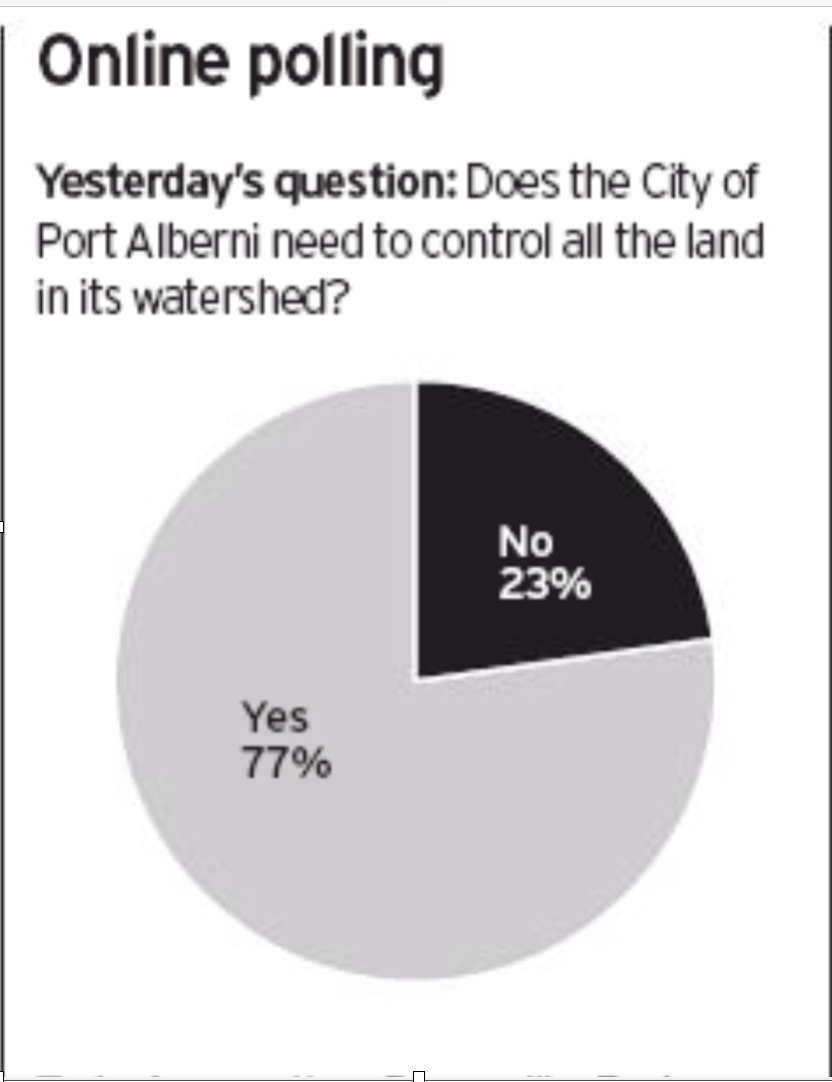
What would we protect? Where is it?
Below, outlined in red, is the area that would make sense to bring into the City. It includes the China Creek (Lizard Lake) and Ship Creek (Bainbridge Lake) watersheds which provide primary and secondary water sources to the City of Port Alberni (CPA) respectively.
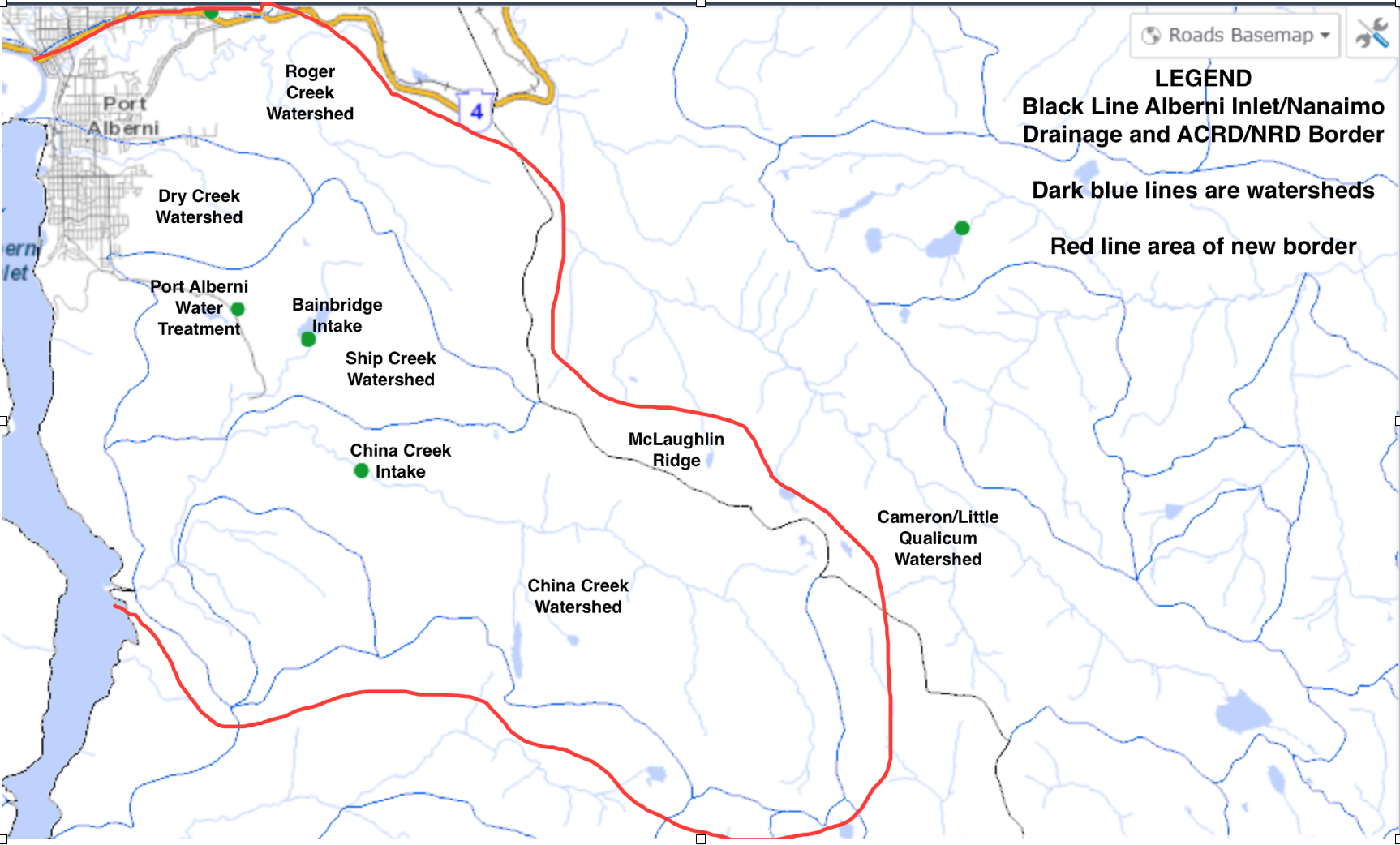
Also in the image and included within the potential boundary:
- Roger Creek Watershed – an important large creek that enters the City from the East. The boundary would include a portion of this watershed before it enters the City. Much of this area has been logged recently. It was also the historic water supply for the Town of Alberni. The original water source is now a popular attraction known as the “Hole in the Wall“. A new bridge over the “Redford Extension” was installed by the Province of BC in 2015 to replace a culvert that was at risk of failing due to strong flood events and logging debris.
- McLaughlin Ridge – A critical area of steep terrain and old growth forest that protects the north – east boundary of the China Creek Watershed. McLaughlin Creek feeds into China Creek about 800m before the City’s primary water intake. It is currently being or expected to be logged.
- Port Alberni (Bainbridge) Water Treatment Plant – this facility, newly built in 2016, treats all raw water coming into the City of Port Alberni with UV disinfection and Chlorine injection. It does not include filtration.
- Dry Creek (aka. Owatchet Creek) Watershed. A small watershed between Bainbridge Lake and the existing eastern boundary of the City of Port Alberni. The creek is susceptible to flooding, particularly during strong storm and high tide events, within its lower reaches due to historic diversions of its natural water course. A $2.7 Million project was completed in 2015 (after a 2013 City report) to mitigate flooding effects and improve survivability for salmon within the creek.
- Upnit Power Project. Not included on the map, it is located not far and upstream from the China Creek water intake. Road building for the project has created concern in the area from the City and private industry in the past. The City owns a minority (5%) stake in the project and sits on the Board. Hupacasath First Nation is the majority (72.5%) owner.
On the map but not included within the proposed boundary is the Cameron Lake/Little Qualicum River Watershed within the Regional District of Nanaimo.
The water is OK, so why now?
The Island Health authority is currently waving a rule for our water supply. In 2008 in response to the Walkerton water tragedy Island Health enacted the “4-3-2-1†drinking water standard enforced by the Drinking Water Protection Act (DWPA). The 2 refers to “a minimum of 2 separate treatment processes, usually filtration and disinfection†to avoid turbidity over 1NTU. Port Alberni has been granted a deferral on that filtration requirement because we can switch from our primary China Creek supply when it gets turbid in big rain events, to Bainbridge Lake. However, a 2017 Island Health report has a caution for our system.
Risk reduction can sometimes be achieved even where full compliance with treatment objectives has not become a reality. Port Alberni, Ucluelet and Brown’s Bay turned on ultraviolet reactors to augment primary disinfection by chlorination. This provides a level of safety while future filtration technology is selected, designed, constructed and commissioned.
And an example of a system that did not come into compliance after repeated years of boil water advisories.
… from time to time issues surface that require enforcement actions under the DWPA such as when voluntary compliance has been resisted. An example is the Comox Lake watershed, which serves the Comox Valley Regional District water systems. The communities are unable to sustain their existing filtration deferral and will need a more definitive treatment solution, which will include an approved method of filtration. At issue is an ongoing problem in maintaining a consistent quality of source water…
The recommendation from the Provincial Health Officer remains before the Minister for consideration at this time. Mitigation of the source water problems and/or filtration in all likelihood will be required in the Comox Valley to ensure quality, safe drinking water into the future.
Soon after the release of this report Comox Valley Regional District was required to implement filtration and work on a $110 million plant began.
We have not yet begun to have consistent boil water advisories in Port Alberni. How long will that last with the level of activity continuing in our watershed? Now is the time to do everything we can to ensure our water supply remains clean and we keep that deferral.
Our Beautiful, Clean Water.
This is the actual intake at China Creek, the picture was taken in July 2015 when I was lucky enough to visit. This is our main water supply.
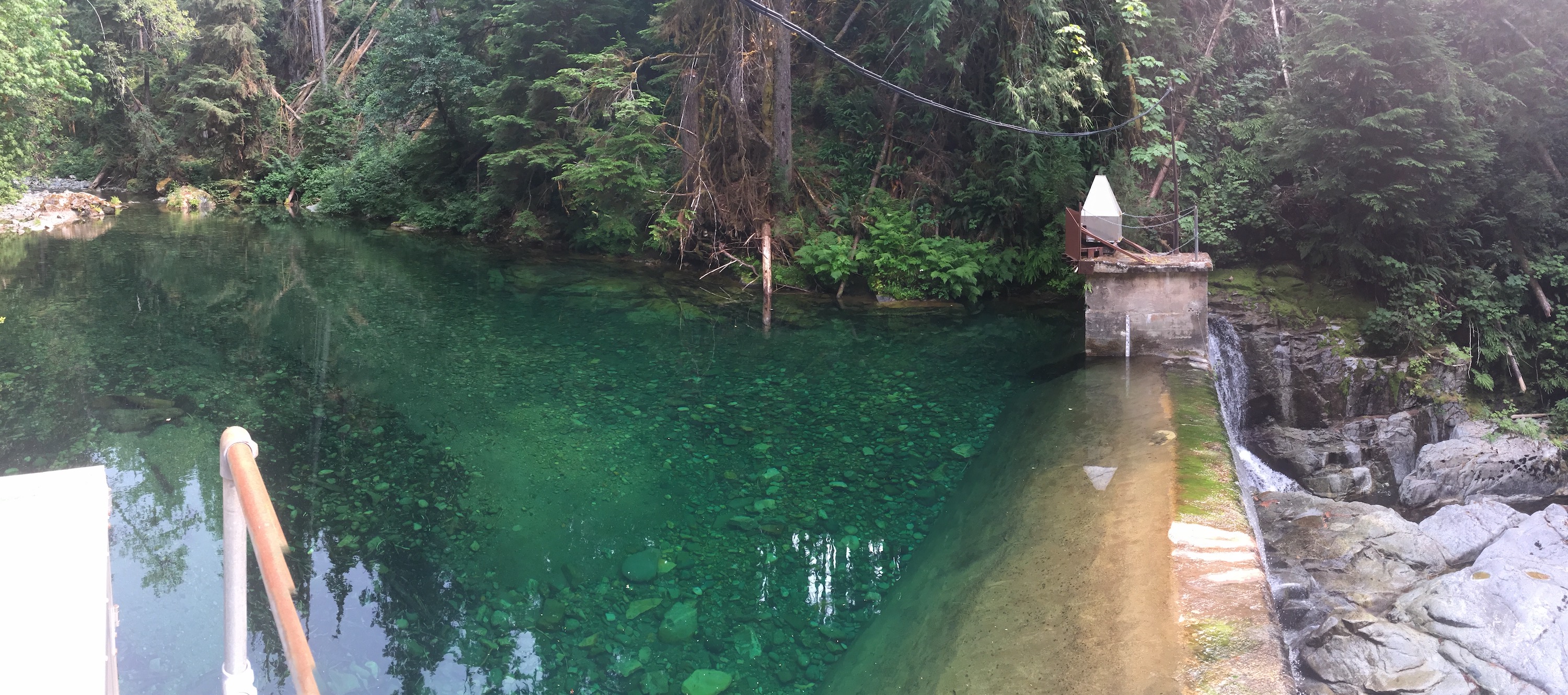
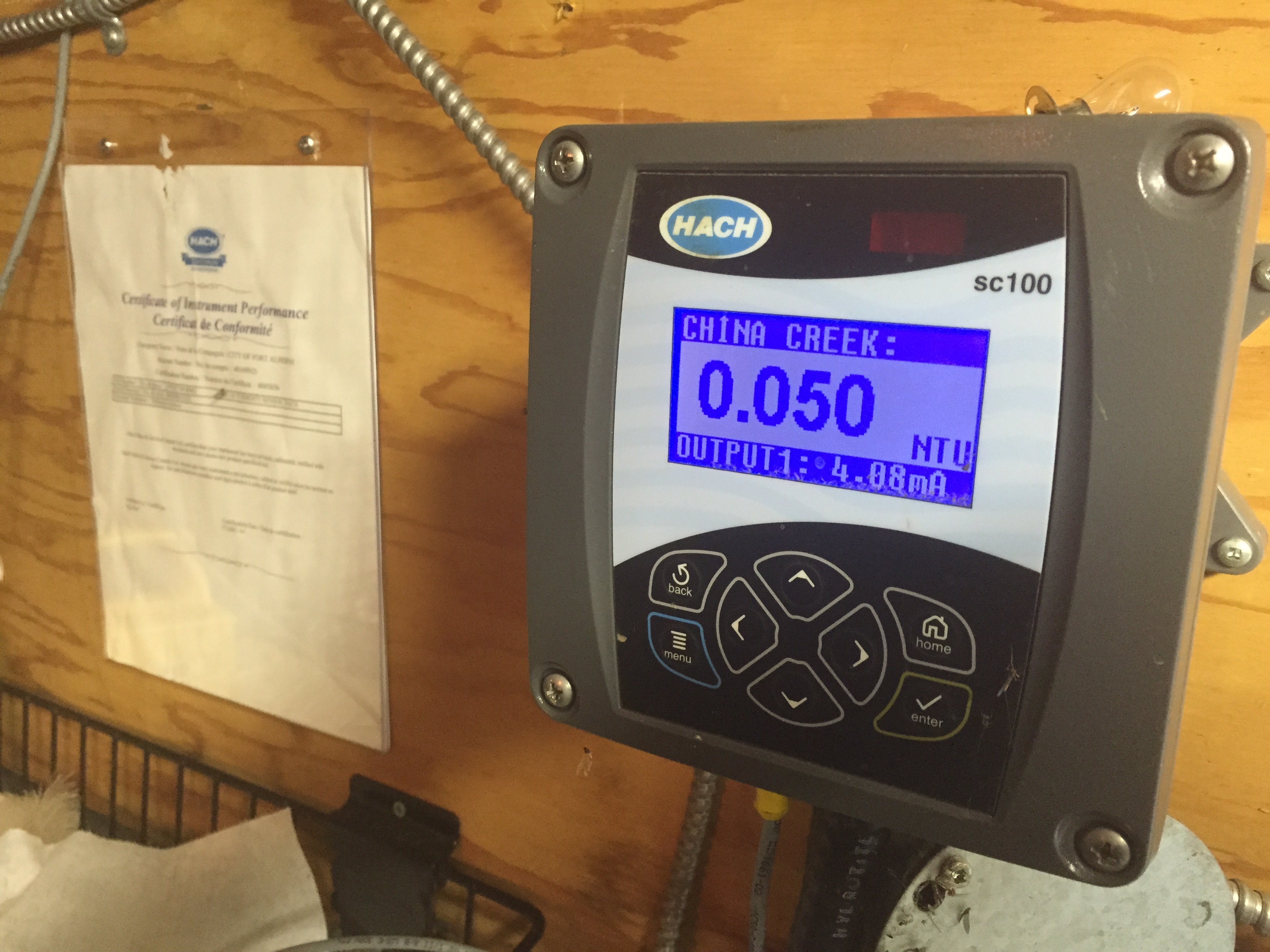
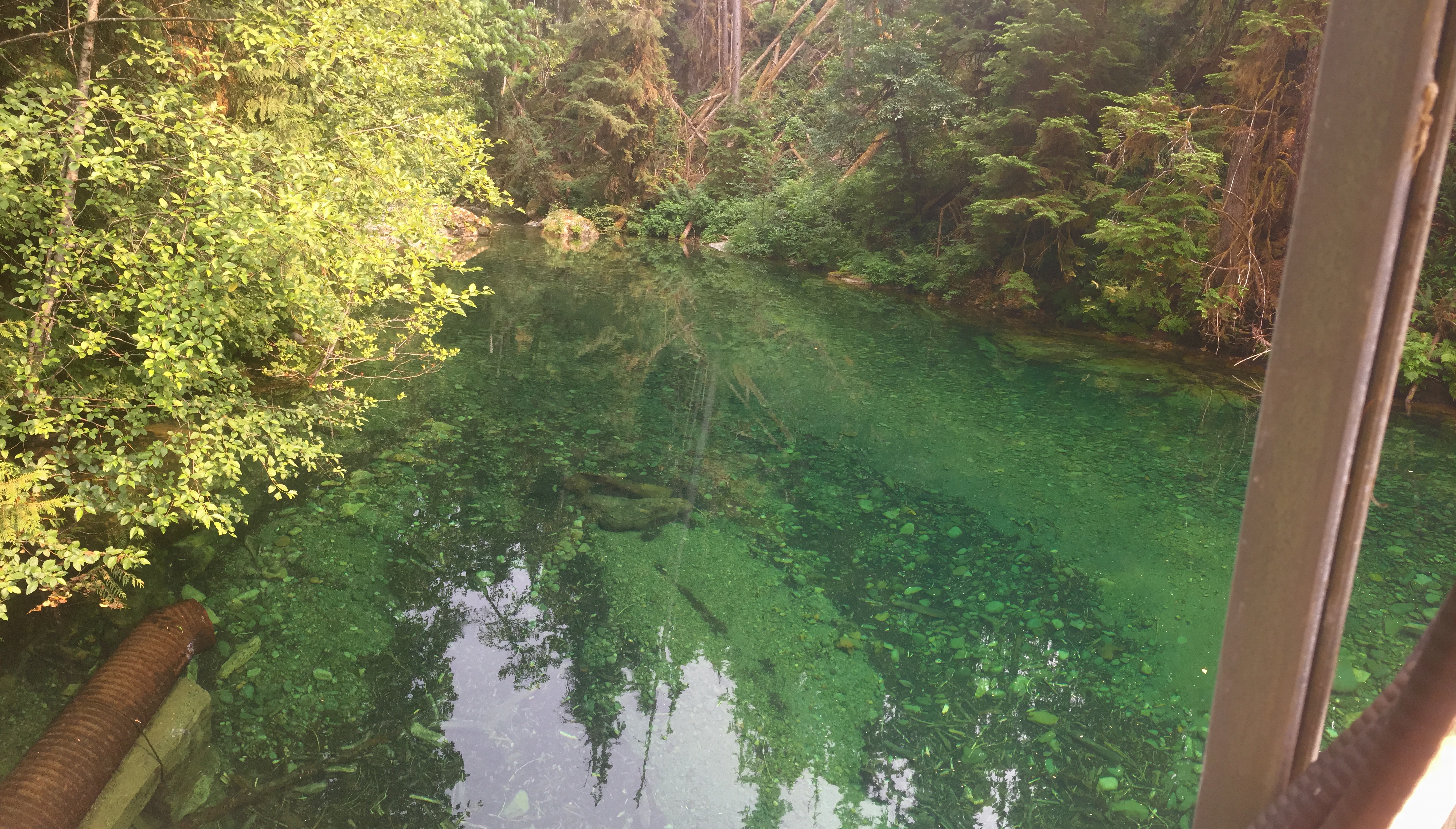
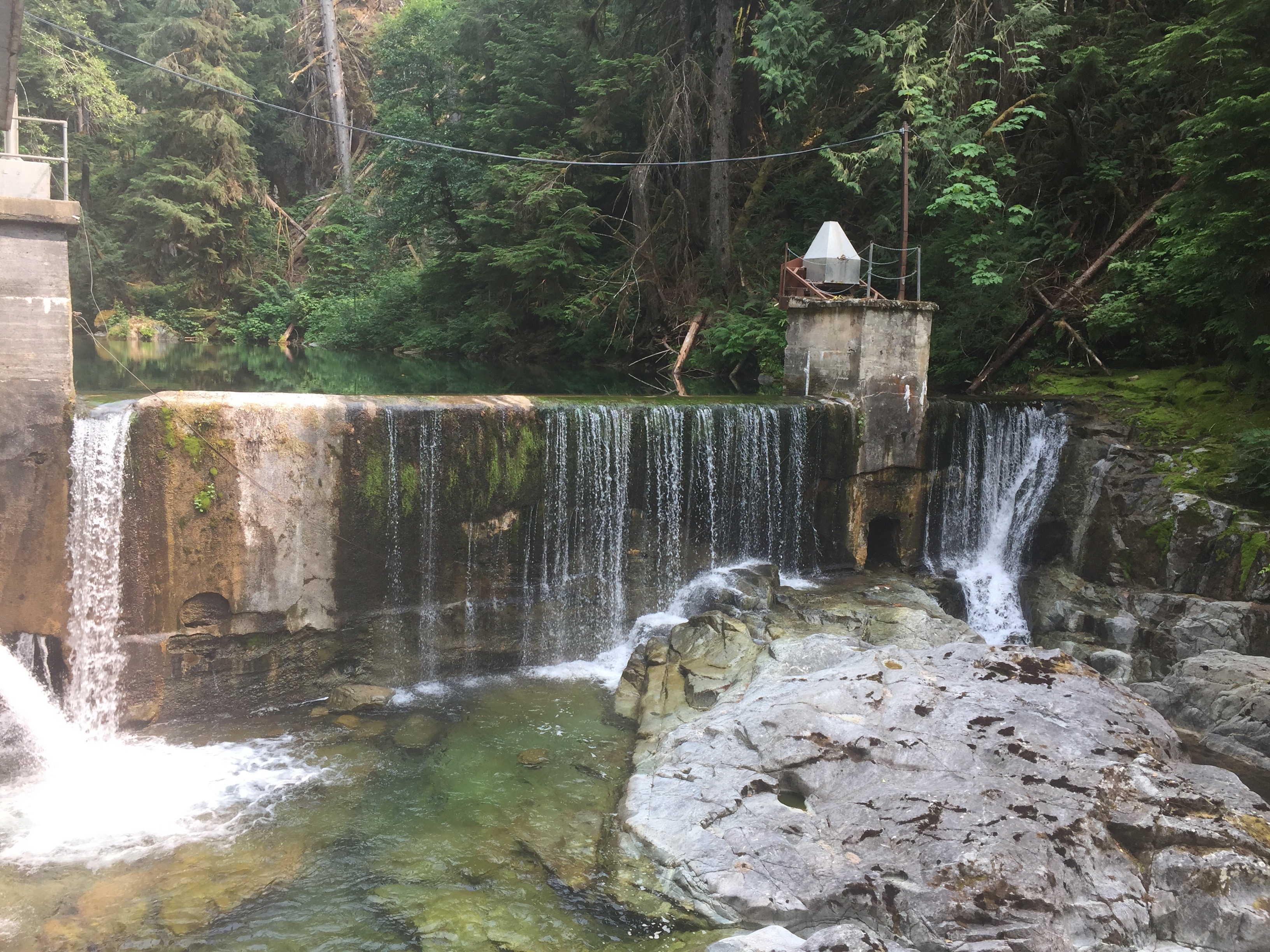
When China Creek becomes too turbid, cloudy, due to runoff from logging operations, forestry roads and land slides the meter can reach over 1 NTU and trigger a boil water advisory. Thankfully, we have a backup.
This is looking south toward Bainbridge Lake, May 2015.

Yes, the picture above is of our secondary supply, our backup. City Council was taken to this cut block by Western Forest Products to show just how innovative their forest practices were within our watershed. When China Creek goes over 1NTU we switch to Bainbridge Lake. I never visited Bainbridge Lake itself, but you can see it in the distance shining just through the trees (what trees are left!).
Here is another picture… this is of Island Timberlands land, just on the northern boundary of the Bainbridge watershed only a short drive away from the Bainbridge picture above. This land feeds into the Roger Creek…. this picture was taken in January 2016 on the Cameron Main Line logging road.
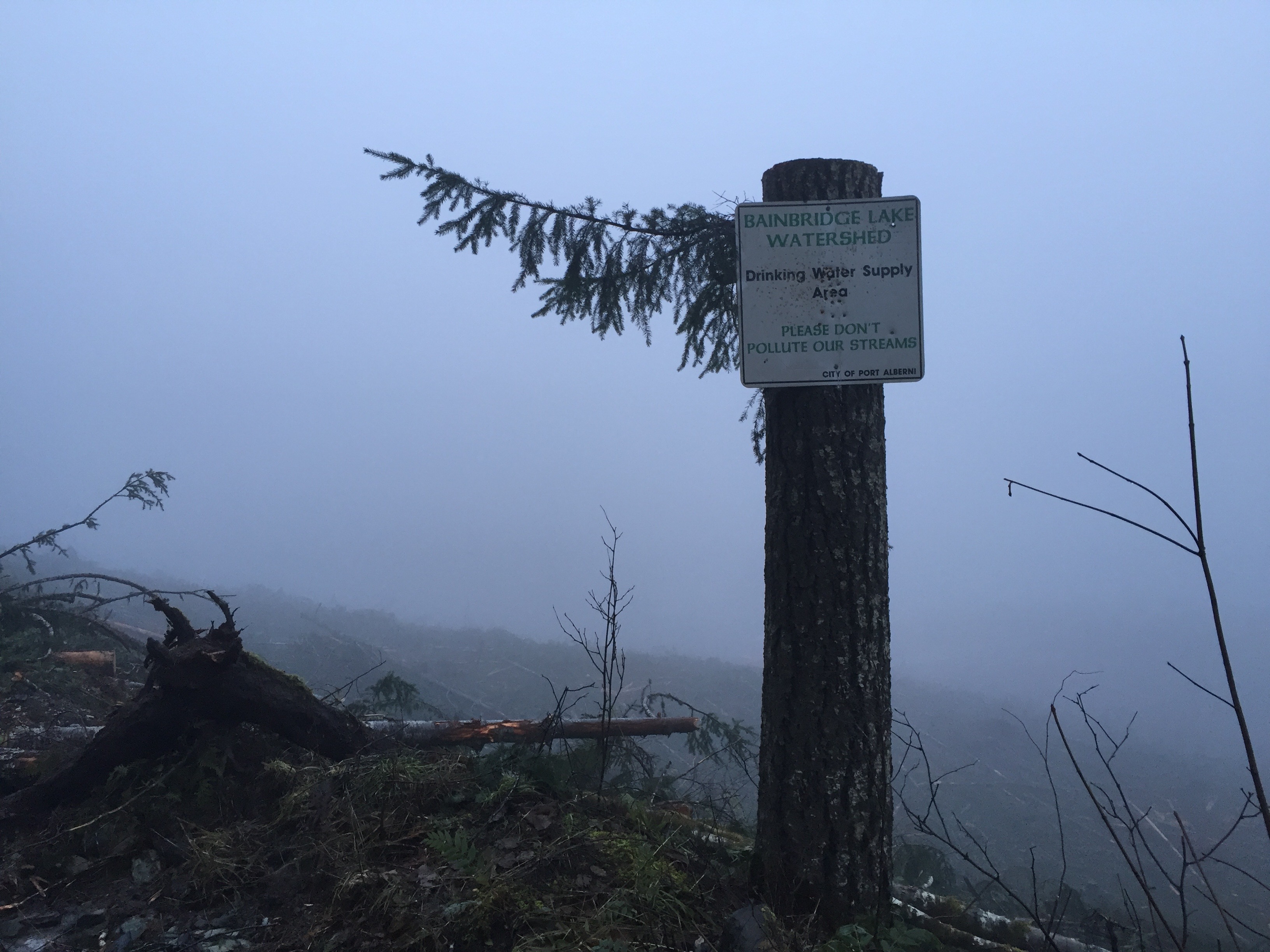
The next day (January 27) after a long rainstorm I returned to find them actively logging at a time they should have been shut down due to rain (to mitigate runoff from logging trucks and equipment into creeks and rivers).
Fun story: When I brought this rather bold example of logging near our watershed to light, I was hauled into the Mayor’s office to have a meeting with Island Timberlands representatives. They were not happy with the bad publicity. Unfortunately, it did not change their practices significantly. We have only continued to see the clear cuts grow.
So What do we do?
We take control of our watershed.
The City of Port Alberni can expand its eastern boundaries to include all areas south of Highway 4 (the red line) up to about China Creek Marina. (The southern boundary of the Cherry Creek district).

This would be an area of roughly 160 square kilometres (160,000 hectares or 39,500 acres). This is a little smaller than Seymour Watershed (195 km2), one of Greater Vancouver’s three protected watersheds. The total Greater Victoria Water Supply Area comprising a number of watersheds is about 200 km2.
It is worth noting at this point that while the land area is large, this change would only bring about a dozen residences and a few businesses into the City mainly along Franklin River/Ship Creek road. By grandfathering rural tax rates and gradually raising them to City rates over a 10-20 year period the few residents or commercial properties affected would avoid shock from any sudden tax increase. It would also bring into the City: the Timberlodge and business in that area south of Highway 4; the San Group (former Coulson) mill on the Alberni Inlet, the “Cameron Shops”, the “Link Mill Site”, and the China Creek Marina and China Creek Log Sort.
How do we take control?
One thing is for sure, barring an outright gift, neither the City nor ACRD, nor any group has the funds to purchase the watershed and own it outright. Greater Vancouver’s watershed has been protected since 1905 when “pressure from the City of Vancouver and Medical health officers” convinced the province into protecting the watersheds when logging interests were looking to move in. There is a great history here. Years before, in 1887, the E&N Railway was built and the Land Grant (or “Land Grab“) to Robert Dunsmuir encompassing 20% of Vancouver Island, was completed including our entire watershed. Because of that, today it is private land whose forests are managed under the Private Managed Forest Land Act (PMFLA).
The only other tool the City has is to create a bylaw banning forestry practices within the watershed.
Unfortunately, the PMFLA has a section within it that says:
21 (1) A local government must not do any of the following in respect of land that is private managed forest land if doing so would have the effect of restricting, directly or indirectly, a forest management activity:
(a) adopt a bylaw under any enactment;….
(2) For certainty, this section applies if the bylaw or permit would have the effect described in subsection (1) even though the bylaw or permit does not directly apply to land referred to in that subsection.
Simply expanding the City boundaries would not violate this Act.
However, the Province must approve all boundary expansions and it would be abundantly clear why the City would be doing this. So the Province may not even approve the boundary expansion without first the City challenging the Act with its intentions to limit logging within those PMFLA areas.
How much would Challenging the PFMLA cost.
That is impossible to know. With enough public pressure and a strong will of Council the Province may not even want to go to court. Or, the City could end up there for quite some time likely running into hundreds of thousands in legal costs.
How would it challenge the Act? That is up for lawyers to decide what aspect of the Act to challenge. However, we have other arms of government, the Ministry of Health in particular demanding we ensure our water is kept to a safe standard. The Province is preventing us from using the most effective and sustainable method (financially and environmentally) of providing safe drinking water to our residents.
Are there other options?
Yes, we could build a mechanical filtration plant for likely more than $50 Million as Nanaimo and Comox Valley have done. Plus the ongoing operating costs…. I and writing this blog in opposition to that option. 🙂
As the land is privately owned and the owners want a return on their investment, as mentioned above, we could try to buy the land but the price would likely be too high.
The Province could also buy the land.
The Province could also enact legislation to ban logging within all watersheds including on Private Forest Lands.
I believe all of those options are extremely unlikely without a major push like this to change the prevailing thinking from technological to natural solutions. As we have seen in Comox and in Nanaimo, the province is very willing to spend money on water filtration facilities, but not on preserving natural filtration facilities.
What we need is a return to the sensibilities of the early 1900s when Greater Vancouver protected its watershed in perpetuity.
Are there benefits other than water protection?
Absolutely.
- Greater community control of access to or not to lands, rivers, lakes and streams within the area for recreational purposes.
- Benefits for all ‘downstream’ natural systems including salmon bearing streams.
- More direct say and control over two major entrances to the City from the East (Highway 4) and South (Bamfield road).
- Tax revenue from private forest land.
- Flood mitigation to prevent large water flows into City creeks and rivers.
- Wildlife; bears, cougars, deer, birds, elk, and thousands of other species live in the forests around our community and have been seriously impacted by logging operations.
- A return at least in part to public control, including First Nations, of land that was given to private coal barons over one hundred years ago with no thought to the ancient, or future, use of the land. The CPA currently provides water to the Tseshaht and Hupacasath reserves closest to the City. These lands are within the traditional territories of the Tseshaht and Hupacasath. Hupacasath also controls some small blocks of crown land near the existing eastern boundary of the City.
- Fire Protection: An intact, aging, and properly managed forest is the best defence against forest fires.
Imagine a view all the way to Mt. Arrowsmith without a single clear cut.
Please write in your support.
If you believe this is something the City should pursue, please write in your support. Write to the Editor. Write to City Council, and the Province. Leave a comment here. Talk about it on Social Media. Lets get the conversation started about protecting our watershed.
Here are some places to write:
- AV News: editor@albernivalleynews.com
- Times Colonist: letters@timescolonist.com
- City Council: citypa@portalberni.ca
- Scott Fraser MLA: Scott.Fraser.MLA@leg.bc.ca
And for the record, yes, I did bring this idea to people at the City a few times over the past four years. That’s all I can say about that.
Addendum
It is worth noting that the Cherry Creek district’s 2012 Official Community Plan does mention the fact that the City of Port Alberni’s water supply area is fully within its district. It very reasonably and kindly notes:
Large tracts of the Cherry Creek electoral area are forested, providing wildlife habitat, stream protection, and buffers between potentially conflicting uses. Forestry-related activities provide economic activity and employment. The community’s main drinking water source, which is also the City of Port Alberni’s main water source, is located in forestry lands.
5.1 Resource ObjectivesObjective 5.1.1 Maintain a forested land base that contributes to fostering a viable and sustainable forestry industry.
Objective 5.1.2 Maintain forest cover throughout the Plan area so that the hydrological integrity of the watersheds is maintained in
order to protect drinking water sources.
Given the accelerating clear cutting of forests in and around the watersheds and within the Cherry Creek area (including around Cherry Creek’s own water supply of Cold Creek and Lacey Lake) the policies have been completely ineffective. Cherry Creek Water District is in fact itself preparing to build its own filtration plant. They may choose instead to connect to the adjacent City of Port Alberni water system.
Advocacy Policies
Policy 5.2.4 Encourage large-lot land owners to retain tree-cover by using selective harvesting methods and practices that protect and maintain slope stability and soil integrity.
Policy 5.2.5 Urge the use of private forest lands and Crown lands be conducted in a manner that does not jeopardize existing and future domestic water quality, flow and supply, and minimizes deforestation.
Policy 5.2.6 Encourage the provincial government to monitor the effectiveness of resource policies and regulations that ensure and support sustainable forest practices and protect drinking water sources on all privately-owned forest lands.
Policy 5.2.7Encourage the ministry responsible for forests, major forest companies, community forest operators and small-scale logging operators to utilize best forest management and harvesting practices to ensure a sustainable forest resource base while preserving local water resources and other significant environmental features.
Thanks for reading!
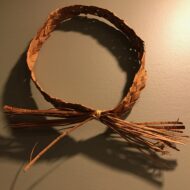
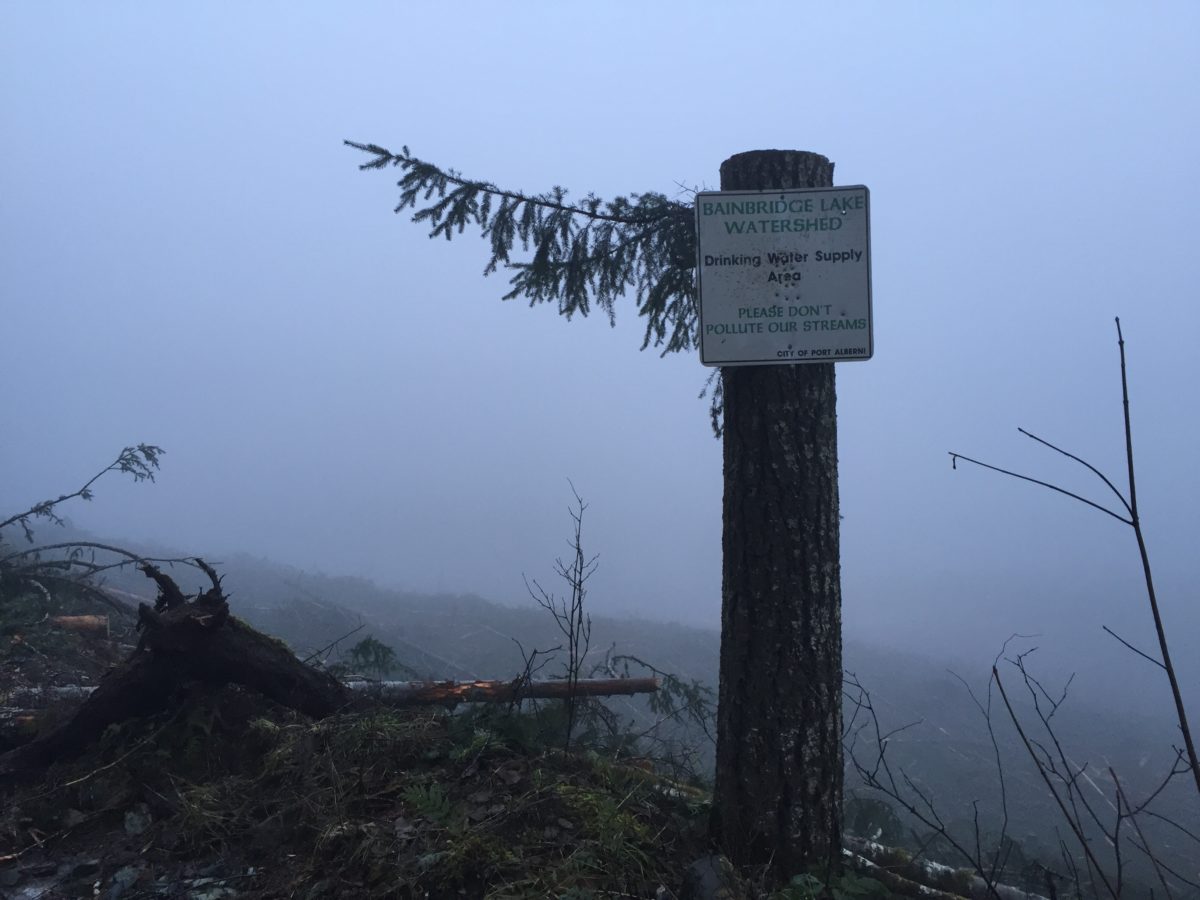
There was $500,000,000 allocated in the last Federal budget to partner with other organizations for buying back sensitive ecological areas that were privately owned.
It was called the Nature Fund (more info at https://www.budget.gc.ca/2018/docs/plan/chap-04-en.html ).
Was this ever brought to the city’s attention?
This is great! No! This is the first I have heard of that.